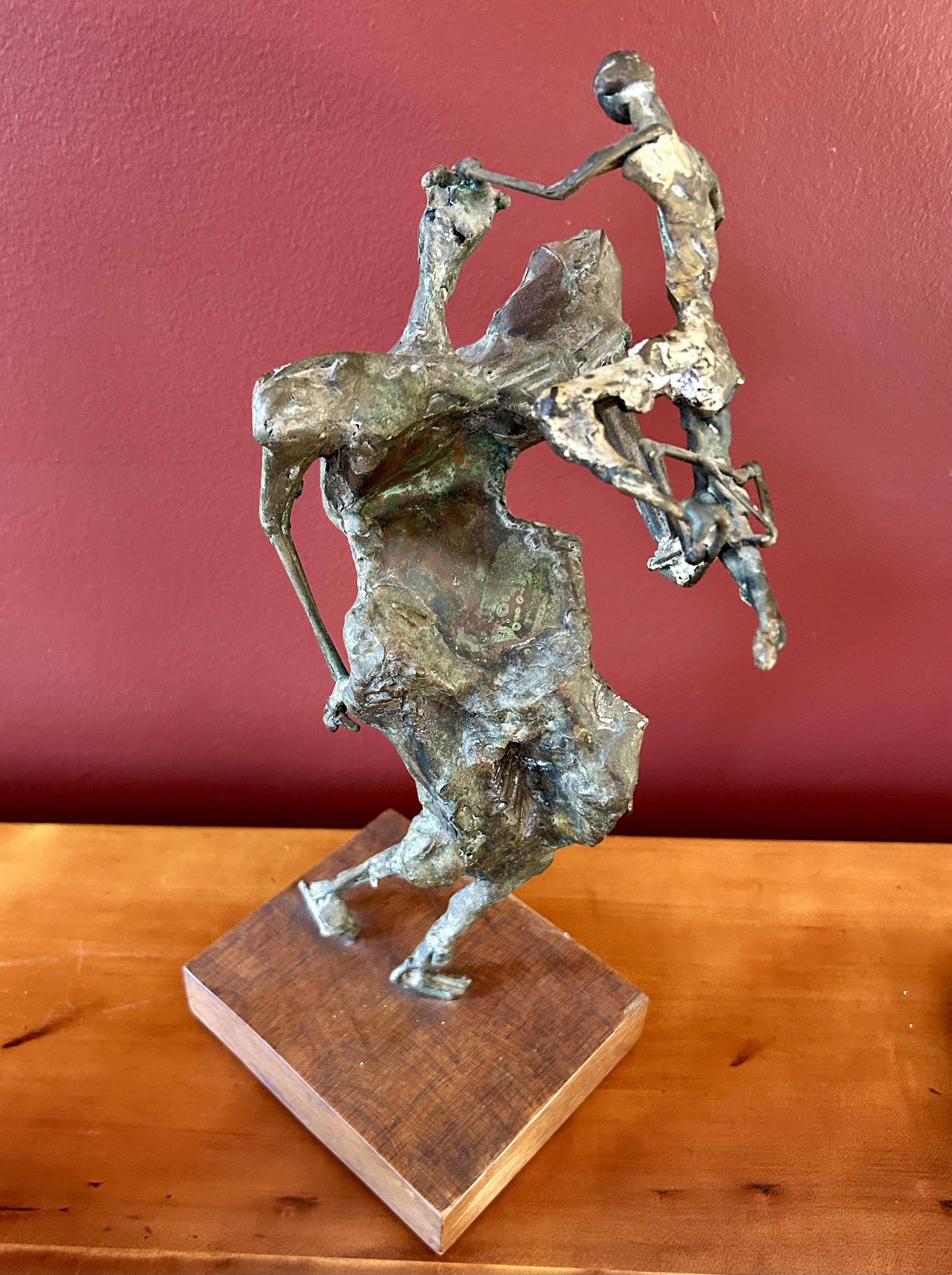A Woman’s Wide Shoulders, Giacometti Style
Wouldn’t it be wonderful if this was a Giacometti sculpture? Highly unlikely as he was Swiss, working in Paris, and I found this sculpture at an estate sale in my Illinois town 30 years ago. The statue was cast in metal, possibly bronze, and secured to chunk of wood. I see a woman, wide shoulders and flared hips, holding a child in her left arm, with the child resting a hand on her head for balance. There are no markings, and no identifying information. The figures are very abstract, but often I am startled when visitors simply cannot see the woman and child.
The work seems similar to sculptures made by Alberto Giacometti (1901-1966). Before WWII Giacometti’s statues were small, some smaller than a few inches! His early work was with the Surrealists in Paris, but they kicked him out as his figures were too “realistic” for them. While he did produce various types of art, he continually returned to the human form. His work, as well as my mystery piece, was created by building a model with clay (or wax), working the piece with fingers, knives or chisels to created desired effects. When satisfied, the piece is cast in plaster to create a mold. Molten bronze is then poured into the mold, which melts the clay (or wax) form and creates the statue. A different technique is to create a re-usable mold from the original clay/wax sculpture, allowing the statue to be cast multiple times. Until the mold is destroyed, the piece can be continually recast, as happened to Edward Degas’ (1834-1917) work after his death. Giacometti actually did produce re-usable molds, though he tended to “rework” each piece.
Interestingly, I had attached a note to the bottom of the piece when I purchased it. I must have asked about its history, and the seller indicated it was picked up by their deceased relative at the estate sale of David Adler. My mystery deepens! David Adler (1882-1949) was a well-known architect in the Chicago area, designing remarkable estates for very wealthy clients (http://architecture-history.org/architects/architects/ADLER/bio.html). He studied in Paris, and traveled through France. He died a widower at age 67 in a home in Libertyville. (That home, The Adler Center, was donated to the town of Libertyville by his heirs and has remained a local art center for our community). The sale my sculpture was originally sold at was for David Adler’s estate (he had no children) in 1950 or so, purchased by a local family, and then sold again to me nearly 30 years ago. Given the wealthy clients Adler worked for it is possible she was a gift to him, or Adler could have purchased her in France and so I’m not betting against the statue being a Giacometti!
Giacometti’s work often featured human figures, and after WWII, he created the elongated single figures he is known for. Giacometti “whittled his subjects down to heavily worked but stick-thin figures…[His] expressive figures became associated with existentialist ideas and a sense of post-war trauma…“Reduced, as they are, to their very core, these figures evoke lone trees in winter that have lost their foliage” (https://www.tate.org.uk giacometti). In addition, he is well known for his work having very small scale heads in proportion to the bodies, much like my statue has.
My “Mother” statue has textural details resembling those of Giacometti’s work, and the elongated female and child, with their off-balance orientation, creates a sense of movement and challenging perspective. The peculiar stick thin arms and legs, and the elongated neck of the woman are not a “portrait” of someone, though Giacometti wrote that he created his art from his viewpoint of a model, with some of the features being distorted due to the perspective he saw. The child, while clearly younger than the female, is also oddly thin and elongated. To hold an older child as such would be rather impossible, but a baby would not be so long limbed. I do sense the idea of bare trees in winter, with the odd stick limbs and sharp angular shoulders.
Those shoulders, to me, are the defining feature, and evoke a difficult time in my life, as a daughter and as a mother. Back in 2010 my father had died, and my mother, Barbara F. Humphrey (1928-2021), facing widowhood and early stages of dementia, was struggling through a painful family rupture. She was scared, felt abused by some of my siblings, and relied on me a great deal. It was a difficult time, one that left many scars on my heart, but I was blessed to have a husband and children who supported my need to often fly to Florida to help Mom. As we were at the end of the process of relocating her – and trying to settle my father’s estate as my mother desired – my mother gifted me a simple diamond necklace. She told me that I had strong shoulders, ones she relied on a great deal, and she was incredibly grateful for all my strength, support and love. I have worn the necklace ever since, and recognize how important it is for women to be strong, to have broad shoulders, as they face the obstacles life throws them. I have been rock climbing for over 20 years, and thus literally have strong shoulders. But Mom was referring to my emotional shoulders – the ability to offer her my strength to help her get through such a fraught time. Rest in peace, Mom, you earned it.

